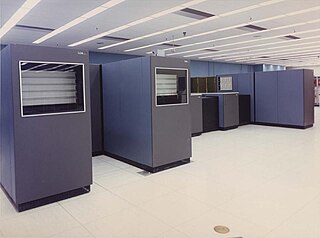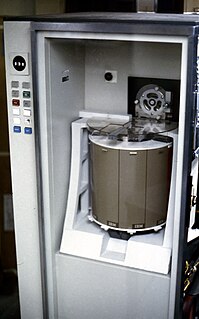 W
WIBM eServer was a family of computer servers from IBM Corporation. Announced in the year 2000, it combined the various IBM server brands under one brand. The various sub-brands were at the same time rebranded from:IBM AS/400 to IBM eServer iSeries, i for Integrated. IBM RS/6000 to IBM eServer pSeries, p for POWER IBM Netfinity to IBM eServer xSeries, x for eXtended architecture IBM S/390 to IBM eServer zSeries, z for Zero downtime
 W
WThe IBM 727 Magnetic Tape Unit was announced for the IBM 701 and IBM 702 on September 25, 1953. It became IBM's standard tape drive for their early vacuum tube era computer systems. Later vacuum tube machines and first-generation transistor computers used the IBM 729-series tape drive. The 727 was withdrawn on May 12, 1971.
 W
WThe IBM 729 Magnetic Tape Unit was IBM's iconic tape mass storage system from the late 1950s through the mid-1960s. Part of the IBM 7 track family of tape units, it was used on late 700, most 7000 and many 1400 series computers. Like its predecessor, the IBM 727 and many successors, the 729 used 1/2 inch (12.7 mm) magnetic tape up to 2400 feet long wound on reels up to 10½ inch (267 mm) diameter. To allow rapid tape acceleration, long vacuum columns were placed between the tape reels and the read/write heads to absorb sudden increases in tape tension which would otherwise break the tape. Write protection was provided by a removable plastic ring in the back of the tape reel.
 W
WThe IBM 1360 Photo-Digital Storage System, or PDSS, was an online archival storage system for large data centers. It was the first storage device designed from the start to hold a terabit of data (128 GB). The 1360 stored data on index card sized pieces of stiff photographic film that were individually retrieved and read, and could be updated by copying data, with changes, to a new card. Only six PDSSs were constructed, including the prototype, and IBM abandoned the film-card system and moved on to other storage systems soon after. Only one similar commercial system seems to have been developed, the Foto-Mem FM 390, from the late 1960s.
 W
WThe IBM 2321 Data Cell announced in April 1964 is a direct access storage device for the IBM System/360. It holds up to 400 megabytes of data, with an access time of 95 milliseconds to 600 milliseconds, depending on the addressed strip position and data arrangement in each data cell.
 W
WThe IBM 3590 is a series of tape drives and corresponding magnetic tape data storage media formats developed by IBM. The first drive, having the IBM product number 3590, was introduced in 1995 under the nickname Magstar. The 3590 series of tape drives and media are not compatible with the IBM 3592 line of drives that replaced it. They can store up to 60 GB of data (uncompressed). This family superseded the IBM 3480 Family of tape drives popular in 1980s and 1990s.
 W
WThe IBM 7330 Magnetic Tape Unit was IBM's low cost tape mass storage system through the 1960s. Part of the IBM 7 track family of tape units, it was used mostly on 1400 series computers and the IBM 7040/7044. The 7330 used 1⁄2 inch (12.7 mm) magnetic tape up to 2,400 feet (730 m) long wound on reels up to 10 1⁄2 inches (266.7 mm) diameter.
 W
WCylinder-head-sector (CHS) is an early method for giving addresses to each physical block of data on a hard disk drive.
 W
WMicrodrive is a registered trademark for miniature, 1-inch hard disks produced by IBM and Hitachi. These rotational media storage devices were designed to fit in CompactFlash (CF) Type II slots. The release of similar drives by other makers led to them often being referred to as "microdrives" too. By 2015, Microdrives were viewed as obsolete, having been overtaken by solid-state flash media in read/write performance, storage capacity, durability, and price.
 W
WA punched card is a piece of stiff paper that can be used to contain digital data represented by the presence or absence of holes in predefined positions. Digital data can be used for data processing applications or used to directly control automated machinery.
 W
WIBM's first magnetic tape data storage devices, introduced in 1952, use what is now generally known as 7 track tape. The magnetic tape is 1/2" wide and there are six data tracks plus one parity track for a total of seven parallel tracks that span the length of the tape. Data is stored as six-bit characters, with each bit of the character and the additional parity bit stored in a different track.
 W
WThe IBM System/360, released in 1964, introduced what is now generally known as 9 track tape. The ½ inch (12.7 mm) wide magnetic tape media and reels are the same size as the earlier IBM 7 track format it replaced, but the new format has eight data tracks and one parity track for a total of nine parallel tracks. Data is stored as 8-bit characters, spanning the full width of the tape. Various recording methods were employed during its lifetime as tape speed and data density increased, including PE, GCR and NRZI. Tapes came in various sizes up to 3,600 feet (1,100 m) in length.
 W
WTravelstar is a brand of 2.5-inch hard disk drives (HDD) that was manufactured by Western Digital. The brand was originally introduced by IBM in 1994 with the announcement of the Travelstar LP, a 2.5-inch 300MB 12.5 mm high HDD. IBM began shipping 2.5-inch HDDs in 1990 without this branding.